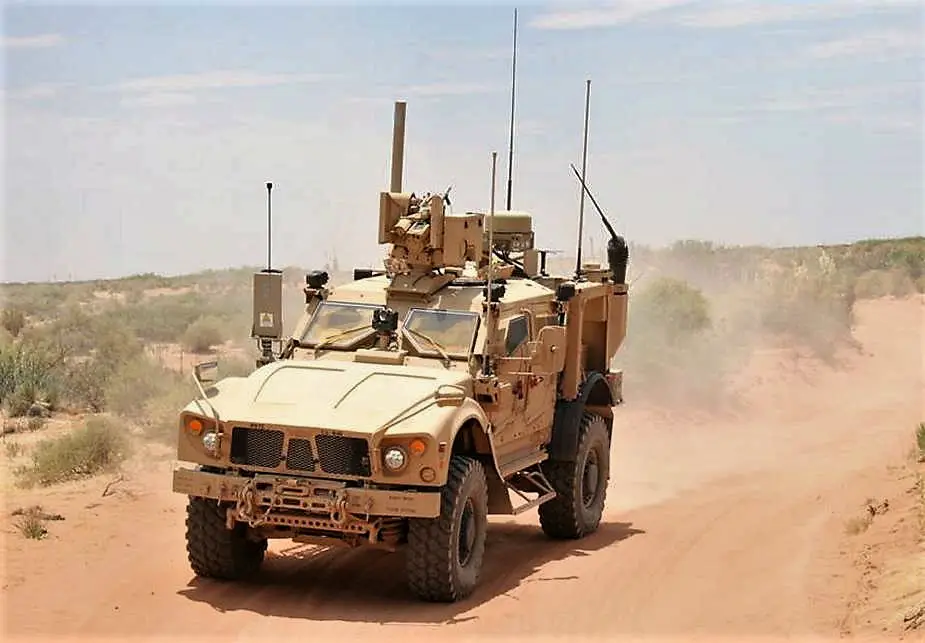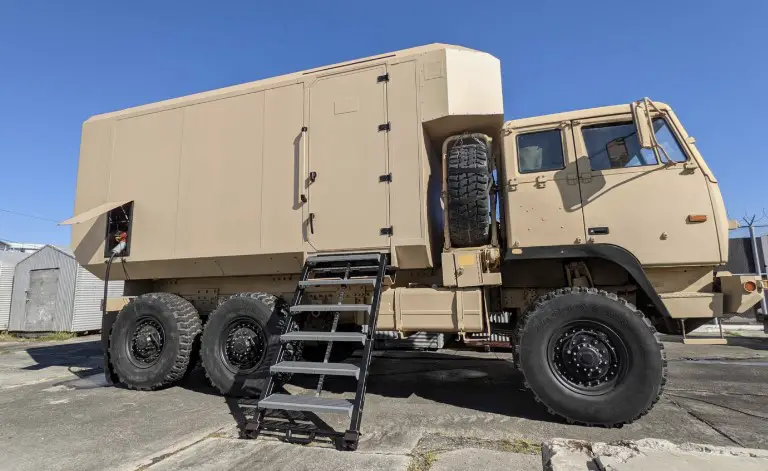According to Matthew Beinart in Defense Daily, the U.S. Army is pursuing two variants of its future intelligence ground station, the Tactical Intelligence Targeting Access Node (TITAN), starting with an “Advanced” version on heavier platforms such as tactical trucks with space direct downlink capability and a “Basic” model designed for platforms such as the Joint Light Tactical Vehicle (JLTV).
Follow Army Recognition on Google News at this link

TITAN Advanced operates on five enclaves. It will be on an FMTV M1083 platform. And then the Basic variant will be on a JLTV platform (Picture source: Oshkosh Defense)
Maj. Jermaine Wright, assistant product manager for TITAN, said the Army will likely procure six Advanced and five Basic TITAN prototypes once it selects a winner for the competition between Palantir Technologies [PLTR] and Raytheon Intelligence and Space [RTX], with plans to move into production in the fiscal year 2026, Defense Technologies reports.
“TITAN Advanced operates on five enclaves. Currently, it will be on an FMTV M1083 platform. And then the Basic variant, which will we get to in prototype maturation once we get to our preferred vendor post-upselect at the end of this phase, will be on a JLTV platform”, Wright told the press. “The TITAN Basic will not have that space direct downlink. The technology is not there as far as antennas and whatnot. So what they will have is space access via the hub-spoke network and a redundant communications network architecture to provide that space data”. TITAN Basic will operate on the unclassified NIPRNet, the classified SIPRNet and the Mission Partner environment while the Advanced variant will function on those three enclaves as well as JWICS for top-secret communications and NSANet, according to Wright.
The TITAN program
TITAN will deliver a next-generation, expeditionary, scalable, and maneuverable platform at an echelon that is purpose-built to address the Army’s number one gap in large-scale combat operations (LSCO): deep sensing. By accessing sensor data from multiple sensors simultaneously across the space, high altitude, aerial, and terrestrial layers, TITAN provides situational awareness and situational understanding across operations. Fusing that data and using advanced analytics to deliver targetable intelligence to lethal and non-lethal networks reduces the sensor-to-shooter gap and enables Long Range Precision Fires (LRPF), aviation and mission command.
TITAN subsumes the functionality of the Army’s legacy ground stations, including the Advanced Miniaturized Data Acquisition System (AMDAS) Dissemination Vehicle (ADV), Advanced Remote Ground Terminal (RGT), and Tactical Intelligence Ground Station (TGS). TITAN’s most significant contribution to Intelligence, Surveillance, and Reconnaissance (ISR) is its modular open system architecture and data management. The increase in sensor data during competition and conflict requires a solution that can receive, process, and store massive volumes of data. The baseline software enables this data integration and processing, and its ability to Task, Collect, Process, Exploit, and Disseminate (TCPED) through Collection management and fusion across domains ensures any sensor can support the right shooter.
AI/ML-enabled capabilities and the first Multi-Link/Multi-Band (ML/MB) antenna are considered critical enabling technologies for TITAN, with plans to research, develop, exercise, and demonstrate them across Army modernization activities like Project Convergence. Samantha Barczak, the TITAN Product Lead within Product Manager Intelligence Systems (PdM IS), said, “Delivering of real-time intelligence with the help of AI/ML algorithms is the future of the sensor-to-shooter chain. TITAN will do the heavy lifting and data processing that will allow Intelligence analysts time and space to make data-driven assessments for commanders at every echelon.”
TITAN’s ability to merge sensor data from every layer increases situational awareness to new levels, but its ability to access national and commercial space data through Direct Downlink and network connections mean the Army will have a capability to sense deep into strategic areas of operation, and directly support future capabilities like Long Range Precision Fires needed against near-peer threats.
Palantir and Raytheon compete
In late June 2022, Palantir and Raytheon each received $36 million, 14-month deals from the Army to build prototypes for evaluation and testing after both companies participated in an initial phase to work through their designs (Defense Daily, June 28). “At the end of this phase, we will have two [TITAN] Advanced prototypes being delivered. But we’ll be taking the preferred winning vendor solution forward and we will continue to iterate with that agile process with that system”, Maj. Jermaine Wright, assistant product manager for TITAN, said.

Titan Alpha working concept vehicle (Picture source: Palantir)














